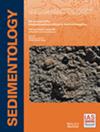Not all shell beds are made equal: Recognizing singular event‐concentrations in megalakes
IF 2.8
2区 地球科学
Q1 GEOLOGY
引用次数: 0
Abstract
Event deposition accounts for a large part of the preserved sedimentary record. Tempestites, tsunamites and turbidites are among the most common event deposits in marine and lacustrine systems. While facies models exist for these deposits, the challenge lies in the fact that diverse triggers can give rise to analogous depositional processes and comparable taphonomic features, making it difficult to pinpoint the precise trigger for an event bed. Hence, five distinct modern‐type shell concentrations are studied in Permian strata from the Paraná Basin, West Gondwana, to access the parameters to discriminate event phenomena, and their associated depositional and taphonomic processes. During this time interval, the basin underwent continuous continentalization due to orogenic events, leading to the entrapment of epeiric marine waters and the transformation of the system into a megalake, supporting a diverse and endemic freshwater bivalve fauna. While sedimentation was primarily influenced by meteorological events, certain stratigraphic intervals were also affected by tectonically active periods and meteor impact events. The different products are categorized into bioclastic sandstone, shell bed, shell‐rich phosclast rudstone and shell‐rich conglomerate that are interpreted as proximal and distal tempestites and tsunamites, respectively. Finally, the products and the processes that lead to the deposition of tempestites and tsunamites are compared to establish diagnostic signatures that may be applied to differentiate these event concentrations in analogous settings from the geological record.并非所有贝床都是一样的:认识巨型湖泊中的奇异事件集中地
事件沉积占保存下来的沉积记录的很大一部分。暴风雨岩、海啸岩和浊积岩是海洋和湖泊系统中最常见的事件沉积。虽然这些沉积物存在面相模型,但其挑战在于不同的触发因素可能会产生类似的沉积过程和相似的岩石学特征,因此很难准确确定事件床的触发因素。因此,我们在西冈瓦纳帕拉纳盆地的二叠纪地层中研究了五种不同的现代型贝壳集中地,以获取区分事件现象的参数及其相关的沉积和岩石学过程。在这一时期,由于造山运动,盆地不断经历大陆化过程,导致澎湃的海水被困,该系统转变为一个巨型湖泊,孕育了多种多样的地方性淡水双壳类动物。虽然沉积作用主要受气象事件的影响,但某些地层区间也受到构造活跃期和流星撞击事件的影响。不同的产物被分为生物碎屑砂岩、贝壳床、富含贝壳的磷酸盐砾岩和富含贝壳的砾岩,分别被解释为近端和远端的暴风岩和海啸岩。最后,对导致天冲石和海啸石沉积的产物和过程进行比较,以建立诊断特征,用于从地质记录中区分这些事件在类似环境中的集中程度。
本文章由计算机程序翻译,如有差异,请以英文原文为准。
求助全文
约1分钟内获得全文
求助全文
来源期刊

Sedimentology
地学-地质学
CiteScore
8.20
自引率
11.40%
发文量
94
审稿时长
6-12 weeks
期刊介绍:
The international leader in its field, Sedimentology publishes ground-breaking research from across the spectrum of sedimentology, sedimentary geology and sedimentary geochemistry.
Areas covered include: experimental and theoretical grain transport; sediment fluxes; modern and ancient sedimentary environments; sequence stratigraphy sediment-organism interaction; palaeosoils; diagenesis; stable isotope geochemistry; environmental sedimentology
 求助内容:
求助内容: 应助结果提醒方式:
应助结果提醒方式:


